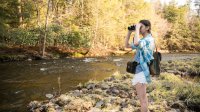Exploring Local Waterways in Place-Based Environmental Education
Studying water sources close to home can connect middle school students to environmental issues in their community.
Your content has been saved!
Go to My Saved Content.In an effort to help students feel more connected to environmental issues and to empower them to take actions that can effect change, I teach my students about eutrophication resulting from fertilizer-rich runoff.
Runoff is water that flows off land toward waterways, often carrying silt, fertilizers, or contaminants. When nutrient-rich water runs off into a body of water, it can lead to increased algae growth, a process called eutrophication. Some of these growths are toxic, affecting the health of local wildlife as well as the enjoyment and economic opportunities of people who live nearby. The effects of eutrophication can be directly observed in my state of New Jersey as well as across the country. However, potential solutions, including strategic fertilization techniques and green infrastructure, can be implemented to rapid effect.
I created the following interactive lesson for my sixth-grade science students that elucidates the mechanisms behind eutrophication to educate students about the way runoff works and some of the issues caused by this phenomenon. This lesson can be implemented over the course of three to four 45-minute class periods using any configuration of remote, hybrid, or in-person learning.
Pre-assessment and Discussion
When introducing nuanced topics, understanding my students’ foundational knowledge within that topic is as important as providing background for them. To that end, when teaching about runoff and eutrophication, I assign a pre-assessment that shows me what ideas students hold about where precipitation goes after it has fallen and why this topic might be important. I use this information to ensure that I address misconceptions and relate our learning to bodies of water that are local or important to my students.
Connecting our learning to my students’ personal experiences helps to grab their interest, so we discuss what our local landscapes look like and create a list of the types of surfaces that are near students’ homes. We then classify each surface as permeable or impermeable and identify potential pollutants that might come from each type of surface.
Exploring Substrates Activity
My students love to see the concepts that we discuss play out in front of them. I provide them with hands-on opportunities when possible to engage them further and to demonstrate some basic ideas about runoff in the exploring substrates activity.
We use three shallow containers, plastic wrap, paper towels, and a cloth towel to simulate three different ground cover types. We use black pepper as the contaminant and pour water over our “substrates” to simulate precipitation. We set up gently sloping ramps that angle into the containers, each with a different substrate covering the ramp. We sprinkle the pepper evenly across the surface of each substrate and slowly pour water over the substrates.
After contamination and precipitation are completed, we compare the amount of water that ends up in each container. Next, we look into the water to see if there is a visible difference in the amount of pepper that we can observe in each.
Depending on time constraints and teacher goals, allowing the water to evaporate as a final step provides an opportunity for students to observe part of the water cycle in action and reinforces the idea that contaminants do not evaporate with water. Afterward, students answer questions designed to get them thinking about the connections they can make, the limitations of the activity, and how the activity relates to water flow around their homes.
Eutrophication Background and Guided Inquiry
At this point in the lesson, students have seen runoff in action and have started to think about contaminants and waterways near their homes. This better allows students to buy into and contextualize the material that is delivered in the following segment.
I present basic background information regarding the process of eutrophication and the fact that human activity can impact the speed and severity of this process. Students then watch Battling the Bloom: Lake Erie and listen to Ocean Shorts: Eutrophication and answer follow-up questions.
The video Green Infrastructure for Runoff helps students better understand the problem of combined sewers and some of the latest ideas that are being used to help minimize urban runoff. Some students are unnerved to learn about combined sewers, a form of infrastructure in which sewage water and runoff are combined in the same drain. These can allow sewage to overflow directly into waterways. Students are also bothered to learn that, although there are inexpensive ways to reduce this kind of runoff, they often aren’t implemented because some consider them inconvenient.
Watershed-Mapping Activity
As a culminating activity, I ask students to put together several of the ideas we have already discussed in a setting of personal significance to them. I have the students create their own watershed maps using NJ Map’s Interactive Atlas, which help them visualize multiple factors, including farmlands and impermeable surfaces in their chosen watershed within New Jersey.
For those outside New Jersey, the American Geosciences Institute website provides links to interactive environmental maps for many individual states. Resources are also available through the United States Geological Survey’s Science Centers, some of which gather data on larger ecoregions rather than individual states.
The process of producing these maps creates an opportunity for me to work one-on-one with students and give clarifications where needed. Students share their final maps, as well as their reasoning for each layer and content choice, to help the class understand the broader picture of New Jersey’s water.
As a closing exercise, students complete the runoff post-assessment to reflect on what they learned about runoff and eutrophication. Students share that they enjoy learning about bodies of water that are familiar and important to them, and they come away with a better understanding of how the runoff process hurts local water sources.
